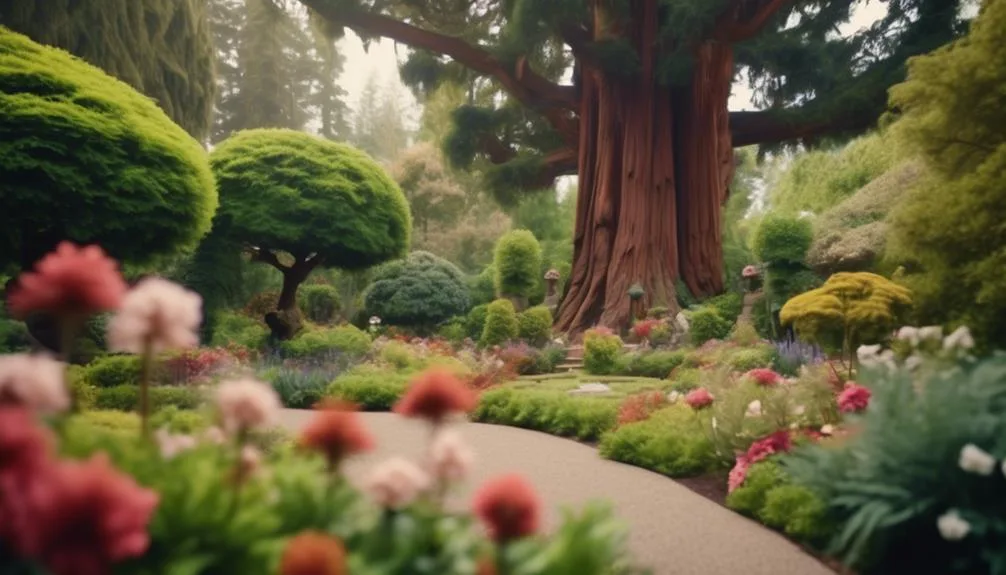Redwood trees can actually be suitable for small gardens, despite their large size. There are several varieties that work well in compact spaces, offering homeowners many benefits.
Before planting one in your garden, it's important to consider a few key factors. Let's explore the potential of incorporating these iconic trees into your small garden and how to make it work for you.
Redwood Tree Size and Growth
To understand the potential size and growth of redwood trees in your garden, it's important to consider their unique characteristics and requirements. Redwood trees have a rapid growth rate, often exceeding 2 feet per year, so they can quickly fill the space in your garden.
Their root system is extensive and can spread widely, so it's crucial to consider containment methods to prevent damage to nearby structures and utilities.
When planting redwood trees in a small garden, it's essential to plan for their future size and the space they'll occupy. Regular pruning and maintenance can help control their growth and ensure they remain a beautiful addition to your garden without overwhelming the available space.
Suitable Growing Conditions
For successful growth of redwood trees in your garden, ensure they're planted in well-draining soil with ample sunlight and sufficient space for their expansive root system. Redwood trees thrive in moist, well-drained soil with a slightly acidic to neutral pH. Opt for a location that receives full sunlight, as redwoods require at least 6 hours of direct sunlight daily.
When it comes to watering, redwoods appreciate deep, infrequent watering to encourage deep root growth. During dry periods, provide supplementary watering to keep the soil consistently moist but not waterlogged.
As for pruning, minimal pruning is generally required for redwood trees, mainly to remove dead, damaged, or crossed branches. Avoid heavy pruning, as it may lead to excessive regrowth.
Following these ideal growing conditions will help your redwood trees flourish in your small garden.
Maintenance and Pruning
After establishing suitable growing conditions for your redwood trees, the next step is to understand the essential maintenance and pruning practices to ensure their continued health and beauty in your small garden. Proper maintenance and pruning are crucial for the well-being of your redwood trees. Here are some key practices to keep in mind:
- Pruning Techniques: Regularly remove dead or diseased branches to encourage healthy growth and maintain an attractive shape. Additionally, consider thinning the crown to allow for better air circulation and sunlight penetration.
- Seasonal Care: Schedule regular inspections and maintenance, especially during the dormant season. This is the best time to prune your redwood trees as it minimizes stress and reduces the risk of sap loss.
- Professional Consultation: If you're unsure about the pruning process, consider consulting a professional arborist to ensure the best care for your redwood trees.
Potential Challenges in Small Gardens
In small gardens, you may encounter various challenges that can impact the health and growth of your redwood trees, requiring careful attention and proactive management.
One significant challenge is space limitations. Redwood trees can grow to be very large, and their root systems can spread widely. In a small garden, this may lead to competition for space with other plants and potential damage to hardscaping or structures.
The expansive root systems of redwood trees can also create obstacles when planting in close proximity to buildings or underground utilities. It's essential to consider the mature size of redwood trees and plan for adequate space to accommodate their growth, including their root systems.
Proper management and planning can help mitigate these potential challenges and ensure the long-term health of redwood trees in small gardens.
Alternatives for Small Spaces
Space limitations in small gardens may lead you to consider alternative options for planting that can thrive without encroaching on other plants or structures. When considering alternatives for small spaces, you can explore the following options:
- Vertical Gardening: Utilize vertical space by growing plants on trellises, fences, or walls. This method allows you to maximize space while adding visual interest to your garden.
- Container Gardening: Opt for planting in containers such as pots, hanging baskets, or window boxes. This approach not only saves space but also provides the flexibility to move plants around as needed.
- Dwarf or Compact Varieties: Choose smaller or more compact plant varieties that are well-suited for small gardens, ensuring they won't overcrowd the space.
These alternatives offer practical solutions for small garden spaces, allowing you to enjoy a lush and diverse garden even with limited room.
Conclusion
Considering the large size and extensive root systems of redwood trees, they may not be suitable for small gardens.
Explore smaller, more manageable tree options that will enhance your garden's natural beauty without overwhelming the space.
Choose wisely to create a harmonious outdoor environment that thrives.

My interest in trees started when I first saw the giant sequoias in Yosemite.
I was a teenager then, and I remember thinking, “I need to learn more about this.”
That moment stuck with me.
A few years later, I went on to study forestry at Michigan Tech.
Since graduating, I’ve worked in a mix of hands-on tree care and community education.
I’ve spent over ten years helping people understand how to plant, maintain, and protect the trees in their neighborhoods.
I don’t see trees as just part of the landscape.
They are living things that make a real difference in our daily lives.
